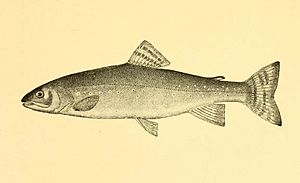Silver trout facts for kids
The silver trout (Salvelinus agassizii) was a type of char fish that is now extinct. It lived in a few lakes in New Hampshire, USA. Scientists last saw this fish in 1939. After that, a survey by the New Hampshire Fish and Game Department could not find any more. Sometimes, the name "silver trout" is also used for rainbow trout.
Quick facts for kids Silver trout |
|
|---|---|
 |
|
| Conservation status | |
| Scientific classification | |
| Synonyms | |
|
Salvelinus fontinalis agassizii |
Contents
What Did the Silver Trout Look Like?
The silver trout was usually about 30 centimeters (one foot) long. People described its color as olive green. In the lakes where they lived, many silver trout would appear in October. This was their time to spawn, which means to lay eggs.
How Scientists Studied the Silver Trout
To learn more about the silver trout, some fish were sent to Harvard University and the U.S. National Museum. This was done to help scientists identify the fish. Also, it helped to prevent local fishermen from catching too many.
At first, scientists thought it was a type of lake trout (Salvelinus namaycush). Later, they thought it was a type of brook trout (Salvelinus fontinalis). In 1885, the fish was officially named Salmo agassizii.
A scientist named W.C. Kendall studied fish in New England. In 1914, he thought the silver trout was related to the Arctic char (Salvelinus alpinus).
What Did Robert Behnke Discover?
Later, another scientist named Robert J. Behnke looked at 13 silver trout specimens. He carefully checked their fins, bones, and gills. He compared these features to other fish species.
Behnke concluded that the silver trout was most closely related to the brook trout. However, it was different enough to be its own unique type. He believed the silver trout developed from brook trout ancestors. This happened in deep, cold, clear lakes in New England. The silver trout became a fish that ate tiny plants and animals floating in the water.
Where Did the Silver Trout Live?
The silver trout was a very rare fish. It lived in only two lakes in New Hampshire: Dublin/Monadnock Pond and Christine Lake in Stark.
These lakes were left behind after a huge ancient lake called Lake Hitchcock disappeared. Lake Hitchcock was a glacial lake that existed for 4,000 years. The silver trout likely evolved from brook trout in this large lake. In the deep parts of Dublin and Christine lakes, the silver trout had no natural enemies.
Why Did the Silver Trout Disappear?
By the late 1800s, more and more tourists visited these lakes for summer vacations. Fishermen wanted to catch more fish. So, they started putting new types of fish into the lakes. These new fish eventually caused big problems for the native silver trout.
Invasive Species and Their Impact
Some of the new fish were especially harmful:
- Yellow perch: These fish eat trout eggs, which means they ate the silver trout's babies.
- Lake trout: These fish competed with the silver trout for food and space. They also ate other char species and could even breed with them.
Other fish were also introduced that have harmed native trout in other places. These included the rainbow trout, brown trout, Atlantic salmon, and rainbow smelt.
Even though the silver trout is likely gone forever, there is still hope for other rare fish. For example, the Pyramid Lake (Nevada) Lahontan cutthroat trout and the Sunapee golden trout have been saved.
See also
 In Spanish: Salvelinus agassizi para niños
In Spanish: Salvelinus agassizi para niños


